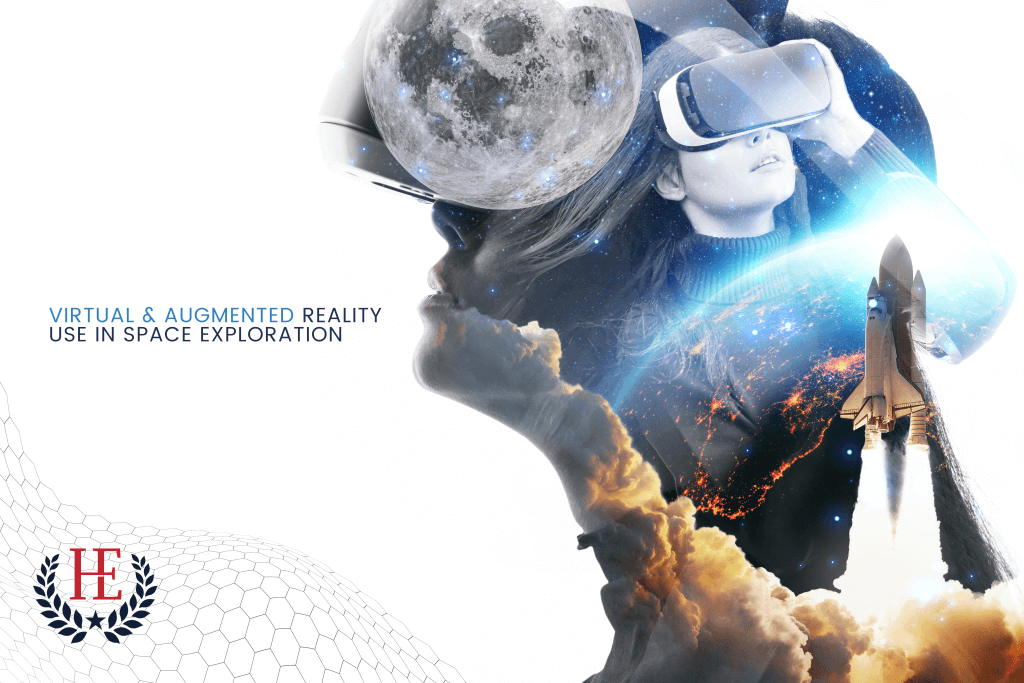
Contributors: Rachel Bryars and Andrea Pressnell
Graphic Design by: Nicole Szews
Virtual and augmented reality training are increasingly becoming a necessary cutting-edge component across industries. In addition to gaming, medical, military, and entertainment applications, the space industry also is fast adopting these technologies.
From astronaut training to maintenance assistance, extended reality technologies are rapidly changing the way that humans are exploring the solar system.
What Is Virtual and Augmented Reality?
Both concepts fall into a larger category known as Extended Reality (XR). Projects with specific requirements can leverage different capabilities unique to both virtual and augmented reality. The term extended reality can be used to describe solutions that enhance experiences with immersive and interactive technology.
Virtual reality (VR) immerses a user within a digital world. This technology uses three-dimensional renderings to recreate a certain environment or situation, which users access via a specialized headset and other equipment. Pass-through virtual reality can fine-tune the level of immersion.
On the other hand, augmented reality (AR) retains the permanence of the physical world. Digital renderings are superimposed on top of our actual surroundings. This technology allows users to interact with various objects in a familiar location.
Applications for Virtual and Augmented Reality in Space Exploration
There are many exciting applications for virtual and augmented reality in space exploration. This technology makes it easier to train new crew members, develop new technologies, and improve conditions for astronauts aboard space craft.
Below are just some of the potential uses for this technology:
- Robot Control: Many space stations require robotic arms and other remote technologies to complete their missions. Using virtual reality, scientists can test out the remote operations of these robots without the risks of spacewalks, helping develop new and exciting technologies for space stations.
- Astronaut Training: Before boarding a spacecraft, astronauts require a significant amount of training and preparation. Specifically, crew members need to adapt to microgravity in order to successfully live in space. Virtual reality can help astronauts acclimate themselves to changes in time, speed, movement, and other factors, supporting the training process.
- Maintenance Assistance: Augmented reality can help space station crews inspect and maintain various components of a space station. This technology can display guided instructions for conducting onboard experiments. In addition, general habitat maintenance and repair can be carried out with minimal risk to crew.
- Space Education: Space exploration organizations can use extended reality to immerse people in the daily lives of real astronauts. This is not only valuable for potential astronauts, but also for the general public. Providing an immersive experience sparks curiosity and inspires future innovations for the advancement of space exploration and planetary science.
- Conceptual Design: Explorations of future technologies can advance the key capabilities and validate operational concepts for beyond low earth orbit (LEO) missions. Interactive virtual layouts can aid a deeper understanding for flight systems and spacecraft operations as a proving ground for future Lunar and Mars missions.
- System of Systems Analysis: Combine and integrate large datasets to visualize the big picture outlook on project teams from design, manufacturing process, to quality assurance.
Considerations with Virtual Space Exploration
Using extended reality in space exploration can deliver significant benefits. This technology allows for effective and convenient training in a controlled environment. Collaboration in the virtual environment also provides fast communication and integrates remote teams that often operate across the globe. Additionally, extended reality can take place anywhere and may reduce costs for space organizations.
However, it can take some time to adapt to a virtual environment and some astronauts may prefer exclusively hands-on, traditional training approaches. It is important for space organizations to make a careful decision to implement these technologies and develop training plans that meet the needs of their crew members.
Speak to the Experts at HigherEchelon
If your organization is interested in extended reality technologies, you need gaming and simulation experts who can help you realize your goals. At HigherEchelon, our team has the skills, experience, and knowledge necessary to implement immersive training for your needs, helping bring your learners closer to the real experience.
Contact us today to discuss your virtual or augmented reality needs. You can call us at 256-724-8843, email us at solutions@higherechelon.com, or fill out our online form for a free consultation.